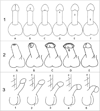Do adult men with untreated hypospadias have adverse outcomes? A pilot study using a social media advertised survey
- PMID: 24613143
- PMCID: PMC4153791
- DOI: 10.1016/j.jpurol.2014.01.024
Do adult men with untreated hypospadias have adverse outcomes? A pilot study using a social media advertised survey
Abstract
Objective: Hypospadias is usually treated in childhood. Therefore, the natural history of untreated mild hypospadias is unknown. We hypothesized that men with untreated hypospadias, especially mild, do not have adverse outcomes.
Materials: Facebook was used to advertise an electronic survey to men older than 18 years. Men with untreated hypospadias identified themselves and indicated the severity of hypospadias with a series of questions. Outcomes included: Sexual Health Inventory for Men (SHIM), penile curvature and difficulty with intercourse, International Prostate Symptom Score (IPSS), Penile Perception Score (PPS), psychosexual milestones, paternity, infertility, sitting to urinate, and the CDC HRQOL-4 module.
Results: 736 men completed self-anatomy questions and 52 (7.1%) self-identified with untreated hypospadias. Untreated hypospadias participants reported worse SHIM (p < 0.001) and IPSS scores (p = 0.05), more ventral penile curvature (p = 0.003) and resulting difficulty with intercourse (p < 0.001), worse satisfaction with meatus (p = 0.011) and penile curvature (p = 0.048), and more sitting to urinate (p = 0.07). When stratified by mild and severe hypospadias, severe hypospadias was associated with more adverse outcomes than mild hypospadias.
Conclusion: Men with untreated hypospadias reported worse outcomes compared with non-hypospadiac men. Mild untreated hypospadias had fewer adverse outcomes than severe hypospadias. Research is needed to determine if treatment of childhood hypospadias improves outcomes in adults, especially for mild hypospadias.
Keywords: Chordee; Hypospadias; Penile curvature.
Copyright © 2014 Journal of Pediatric Urology Company. Published by Elsevier Ltd. All rights reserved.
Conflict of interest statement
None.
Figures

References
-
- Baskin LS, Ebbers MB. Hypospadias: anatomy, etiology, and technique. J Pediatr Surg. 2006;41(3):463–472. - PubMed
-
- Kraft KH, Shukla AR, Canning DA. Hypospadias. Urol Clin North Am. 2010;37(2):167–181. - PubMed
-
- Snodgrass WT, Bush N, Cost N. Tubularized incised plate hypospadias repair for distal hypospadias. J Pediatr Urol. 2009;6(4):408–413. - PubMed
-
- Snodgrass WT, Bush N, Cost N. Algorithm for comprehensive approach to hypospadias reoperation using 3 techniques. J Urol. 2009;182(6):2885–2891. - PubMed
-
- Brouwers MM, van der Zanden LF, de Gier RP, Barten EJ, Zielhuis GA, Feitz WF, et al. Hypospadias: risk factor patterns and different phenotypes. BJU Int. 2010;105(2):254–262. - PubMed
Publication types
MeSH terms
Grants and funding
LinkOut - more resources
Full Text Sources
Other Literature Sources

